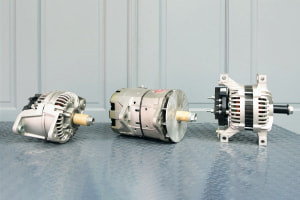This course will teach you about using generators, an electrical machine that converts mechanical energy into electrical energy. Alternators are lighter and more cost-effective compared to DC generators. Since the generator uses slip rings, it has a longer life than a commutator in a DC generator. There are also developments such as ‘brushless excitation’ systems that eliminate the need for brushes, slip rings and commutators. In this system, you only need a 3-phase AC exciter and a group of rectifiers to supply DC power to the generator. Both AC generators (alternators) and DC generators work on the principle of electromagnetic induction. We will introduce you to the theory of alternators and the methods used to generate EMF and Faraday's Law. You will also learn about the components and construction of alternators in particular. Want to know how to derive the equation for the EMF generated by a generator? This course will demonstrate this equation with the help of examples.
The course then explains three-phase windings and the waveform of three-phase output voltage. We will discuss the generation of three-phase voltages in alternators and star and delta circuits. We will also examine the role of rotors and damper windings in alternators. You will learn about the characteristics of alternators, the open circuit and the short circuit characteristics. Would you like to know how armature resistance, voltage regulation, synchronous impedance and synchronous reactance work? We will cover these critical topics and study the excitation system using the DC exciter. Next, we will research why we need automatic voltage regulators in a generator. You will learn about operating a generator with a carbon stack regulator and operating a generator with an oscillating contact. We will look at the phase sequence in the AC system, including how the phase sequence indicator works.
In the last section, you will learn what conditions must be met for synchronisation. Then we will define the ‘lamp’ methods for checking synchronism and generators' parallel connection or synchronisation. In addition, we will also explore the effects of faulty synchronisation. Next, we will help you understand load sharing and the parallel operation of alternators. Then you will look at additional generators' load management and alternators' power factor management. Finally, investigate the damage to generators if the required conditions are not met. This course is ideal for students or engineers who want to gain knowledge in the use of alternators. So why wait? Start learning today.
What You Will Learn In This Free Course
View All Learning Outcomes View Less All Alison courses are free to enrol, study, and complete. To successfully complete this Certificate course and become an Alison Graduate, you need to achieve 80% or higher in each course assessment.
Once you have completed this Certificate course, you have the option to acquire an official Certificate, which is a great way to share your achievement with the world.
Your Alison certificate is:
- Ideal for sharing with potential employers.
- Great for your CV, professional social media profiles, and job applications.
- An indication of your commitment to continuously learn, upskill, and achieve high results.
- An incentive for you to continue empowering yourself through lifelong learning.
Alison offers 2 types of Certificate for completed Certificate courses:
Digital Certificate: a downloadable Certificate in PDF format immediately available to you when you complete your purchase. Physical Certificate: a physical version of your officially branded and security-marked Certificate All Certificate are available to purchase through the Alison Shop. For more information on purchasing Alison Certificate, please visit our FAQs. If you decide not to purchase your Alison Certificate, you can still demonstrate your achievement by sharing your Learner Record or Learner Achievement Verification, both of which are accessible from your Account Settings.


















 Avg. Hours
Avg. Hours  CPD Accredited
CPD Accredited 
 Total XP:
Total XP: 
 Knowledge & Skills You Will Learn
Knowledge & Skills You Will Learn 


